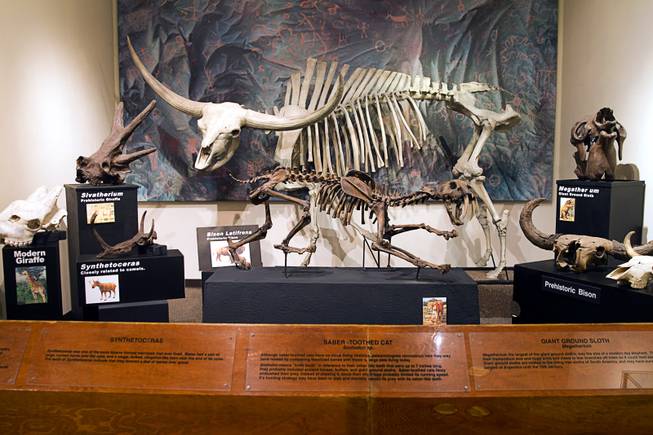
A fossil exhibit is shown at the Las Vegas Natural History Museum, 900 Las Vegas Blvd North, Monday, Oct. 12, 2015. The museum was recently declared a federal repository for all archeological and paleontological finds in Southern Nevada.
Sunday, Dec. 31, 2017 | 2 a.m.
Distinct sciences
Archaeology is the study of human artifacts and remains.
Paleontology is the study of fossils (all kinds, not just dinosaurs).
Both archaeologists and paleontologists unearth interesting information about the past, and their work can overlap, but they are distinct scientific fields.
More than 80 percent of land in Nevada is publicly owned. This wealth of open space is a treasure trove for paleontologists. Their digs into the dirt can teach us about what our world was and hint at issues we might have to confront tomorrow.
We caught up with Stephen Rowland, a geology professor at UNLV, to learn about what the Silver State was like 300 million years ago and what you can find when you look away from the neon lights and toward the dusty earth below our feet.
IDEAL CONDITIONS FOR FOSSIL FORMATION
Not everything becomes a fossil. Of the fossils that do form, few are of complete skeletons. Rowland says there are two characteristics needed for the ideal fossil find:
• Hard Parts. If something lacks some sort of mineralized skeletal parts — think teeth, bones or a shell — it is unlikely to fossilize. “That’s why we don’t have many fossilized butterflies,” Rowland said. “They don’t have that hard, bony skeleton.”
• Quick Burial. When a living creature dies, its body typically becomes fare for other animals. Predators and scavengers often move bones or other hard parts. That’s great for the circle of life, but bad for future generations who’d like to dig up complete skeletons of things past.
NEVADA STATE FOSSIL
Nevada is the only state in the country to have a complete skeleton of an ichthyosaur (genus shonisaurus), an extinct predatory marine reptile that lived 225 million years ago. Ichthyosaur became the official Nevada state fossil in 1977.
The complete skeleton is approximately 48 feet long. It was discovered 350 miles north of Las Vegas near the abandoned mining town of Berlin. That site (now the Berlin-Ichthyosaur State Park) is home to the most abundant concentration of ichthyosaur remains in the world. The reason for the heavy concentration has eluded scientists since the site was discovered in the 1920s.
A MAMMOTH FIND
Rowland is working on unearthing a mammoth believed to be 13,000 to 20,000 years old. Found this year in Amargosa Valley, northwest of Pahrump, the mammoth is noteworthy because it appears to have died standing up. Its tusks are straight up and down, whereas an animal typically dies having fallen sideways. This could indicate that this animal died in quicksand. Rowland and his team are hopeful the site will yield a complete skeleton, which could be possible if their theory is proven correct and other animals did not scavenge or move its bones.
FINDING FOSSILS
Rowland may be the expert on fossils, but he is rarely the one who first finds them. That honor typically goes to hikers, climbers or other outdoor enthusiasts who stumble across something that seems unusual, take a photo and send it to Rowland with questions. “Usually, I can give them an idea,” he says. “Often it’s something that’s not really a fossil, or a very common fossil of no great scientific importance.” But occasionally it’s something of tremendous value — like the Armargosa mammoth.
In Gold Butte National Monument, there is a series of fossilized footprints from a small crocodile-sized reptile that lived 290 million years ago. Rowland says studying footprints helps reconstruct animals’ environment. “It gives you behavior information,” he said. “That’s especially interesting.”
One thing Nevada isn’t known for: dinosaur fossils. For those, you should head to Utah, Colorado or Wyoming. Those states were once on the shoreline of a seaway, making them ideal spots for dino preserving. Nevada was more mountainous and its sand dunes weren’t great for preservation.
WHERE TO GO FOR MORE FOSSIL FACTS
• The Nevada State Museum at Springs Preserve, 333 S. Valley View Blvd., 702-822-7700. Curated exhibits with fossils and information on prehistoric life.
• The Las Vegas Natural History Museum, 900 Las Vegas Blvd. North, 702-384–3466. Curated exhibits and also hosts the Nevada Friends of Paleontology, a nonprofit organization open to the public that meets monthly.
• Tule Springs Fossil Beds National Monument, 16001 Corn Creek Road. Visitors can explore badlands and trenches where an abundance of large animal fossils have been excavated by scientists through the years.

